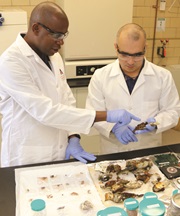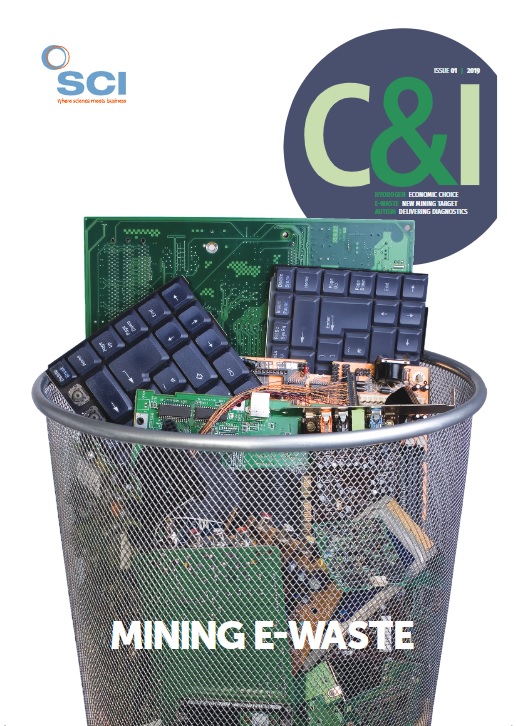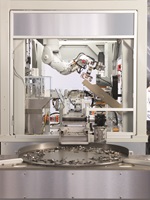Over 1.5bn smartphones will be manufactured globally in 2019, each one filled with valuable minerals and metals such as gold, platinum and silver. On average, they will be kept for just 21 months before being replaced. Over 60% of them will end up in landfills. And even when recycled, some 30% of material will still be lost, because smartphone design, and contemporary recycling systems render its recovery inefficient.
Smartphones represent a fraction of global electronic waste. Discarded electronics are one of the fastest growing waste streams, with the UN predicting that the global e-waste mountain will reach over 52m t/year by 2021. Meantime, we are gradually running out of valuable minerals, such as neodymium, terbium and iridium, that are crucial in manufacturing electronics.
As the scale of the problem is becoming clear, there has recently been a surge in efforts to understand what goes into electronic products, and how it can be recovered, says Susanne Baker from techUK, the association for companies in the digital economy. ‘We are seeing a lot of academic proposals looking at better understanding the flow of products and waste within the economy,’ says Baker, who heads the trade body’s environment and compliance programme.
‘There is a growing understanding of what’s in electrical and electronic products and how to trace it, but I think the challenge remains how to get the most value out of recycling them,’ says Baker. ‘There is so much scope for innovation in this space still.’

Recycling, reinvented
Some of this innovation is coming from the electronics manufacturers themselves. Computer manufacturer Dell has established its own system for recovering gold from end-oflife motherboards and reusing it in new ones. And Apple has developed a robot that can successfully salvage material from discarded iPhones, which then flows into next generation smartphones.
In academe, researchers are chasing more ambitious goals. Convinced that effective recycling technologies alone are not enough to tackle the e-waste crisis, scientists are working towards methods that are also as cheap and profitable as possible. ‘It’s not going to be enough to just recover critical materials, it must be part of an integrated value recoverysystem,’ says Carol Handwerker from Purdue University. Handwerker is on the research committee for the Value Recovery from Used Electronics project, a collaboration of US scientists and industry players, including Google and Microsoft, trying to establish a circular economy for hard disk drives.
In October 2018, the project, run by the International Electronics Manufacturing Initiative (iNEMI), finalised its ‘phase two’, which focused on recovering value from magnets containing rare earth elements and precious metals in circuit boards.1 The team demonstrated seven different ways for taking magnets out of hard drives and recovering the materials in them for reuse in new neodymium-ironboron magnets, Handwerker explains. Which one to choose depends on the state of the hard drive, she says. ‘We’re really aiming for getting the highest economic value. It becomes a cascade of decision-making. Can we reuse the hard drive as a whole? If not, can we reuse parts of it? No? Then we go through a magnet recycling process.’
One of the recycling processes relies on an unusual way of dissolving magnets in water-based solutions that recovers rare earth elements of high purity. Ikenna Nlebedim, a scientist at the Ames laboratory in the US Department of Energy’s Critical Materials Institute (CMI) behind the technology, says it’s ‘so environmentally friendly that I will be fine if a plant based on the process is established near my home’.
This makes it vastly different from other magnet dissolution processes, which rely on using nitric or hydrochloric acids. This has held them back from being adopted in the electronics supply chain because they are costly and produce toxic fumes, acid-contaminated waste and unwanted by-products.
The water-based solution uses salts instead of acids, Nlebedim says, and processes waste magnets through oxidative dissolution. Nlebedim and his team have reclaimed 99.9% pure neodymium oxide from neodymium-iron-boron magnets, as well as 97% pure cobalt oxide and over 99.9% pure samarium from samarium-cobalt magnets.
After applying it successfully to waste magnets, the researchersdiscovered that their technology is remarkably selective in recovering rare-earth elements even from chunks of magnet-containing, shredded e-waste. Hard disk drives, and other valuable e-waste products, are typically shredded to ensure any data on them is destroyed. This makes it much harder to recover valuable metals, and also more costly, because waste has to be sorted and demagnetised before going through a recycling system.
‘The beauty of the process is that it’s economical,’ says Nlebedim. ‘It can treat shredded e-waste directly, without the need to pre-sort or pre-concentrate the magnet content.’ Importantly, this makes recycling profitable for industry. Besides rare earths, other components of the waste, such as copper, electronic circuit boards, and aluminum can be recovered for further recycling. This, in turn, can help pay for the chemicals used in the recycling process, Nlebedim says. ‘We did an economic analysis and found that a company using our technology to recycle neodymium-iron-boron magnets would see a return on investment within two years. For samarium-cobalt it would only take one year.’
As such, the technology has the potential to become embedded in the electronics supply chain; exactly what researchers at iNEMI are aiming for.
|
>52m t/year Predicted mass of the global e-waste mountain by 2021, according to the UN |
|
>60% of smartphones will end up in landfills. Even when recycled, some 30% of material will still be lost |
|
99.9% Purity of neodymium oxide reclaimed from neodymium-iron-boron magnets by a novel recycling process that relies on an unusual way of dissolving magnets in waterbased solutions. The technology has also recovered 97% pure cobalt oxide and over 99.9% pure samarium from samarium-cobalt magnets. |
A lucrative business
‘We have several [e-waste recycling technologies] that are economically viable and environmentally sound,’ Handwerker says. One of these is Nlebedim’s dissolution process.Another is a membrane solvent extraction process. The third turns neodymium-iron-boron magnets into a powder with a hydrogen decrepitation technique. With the help of chemical additives, the powder can be turned into a new, high-performance magnet.
Some of these technologies are still at an early stage of development. But Nlebedim’s process is ready for commercialisation, and some others are either already licensed, or due to be taken up by a company for further development, according to Handwerker. The main challenge left, she says, is getting the electronics industry to use them. ‘[Recycling e-waste] is not going to be done from an altruistic point of view,’ she says. ‘There has to be some commercial driver out there for recycling and reuse.’
Making recycling profitable is an obvious incentive. After all, recycling e-waste cheaply and efficiently is of major economic interest. According to the most recent Global e-waste Monitor report, in 2016 the world’s 44.7m t of e-waste alone – not including vehicles – contained €55bn worth of precious metals and other high value materials.
In 2017, the EU Horizon 2020-funded research consortium, ProSUM developed a European database of valuable materials available for recovery – or ‘urban mining’ – from scrap vehicles, spent batteries, waste electronic and electrical equipment, and mining wastes.2 It mapped the flow of valuable materials recovered or lost in some 18m t of tech products discarded annually in the EU.Europe’s end of life vehicles alone represent a source of secondary base metals like steel (213m t), aluminium (24m t) and copper (7.3m t), as well as platinum and palladium used in car catalysts, the project found.
Meanwhile, the EU and US are under pressure to relieve their reliance on the world’s biggest producer of rare earth elements, China. And legislation too is armtwisting the electronics industry to up its recycling game. In the US, the EPEAT voluntary purchasing standards are encouraging buyers in the public and private sectors to choose electronic products that contain magnets with 5% recycled rare earth content, Handwerker says.
Consequently, she says, ‘there is now a market push for recycling technology. Electronic manufacturers are being asked by their customers how they can increase their EPEAT standard rankings. That’s one big leverage point right now with respect to recycling hard disk drives’.
|
Daisy assembly chain Apple's robot Daisy Ahead of Earth Day in April 2018, Apple introduced Daisy, a robot developed by the company’s in-house engineers to disassemble nine different versions of the iPhone and sort all their reusable components in the process. In all, Daisy is capable of taking apart 200 iPhones in a given hour, and successfully salvage a bulk of the material needed to create brand new iPhones. For every 100,000 devices, it manages to recover 1900kg of aluminium, 770kg of cobalt, 710kg of copper, and 11kg of rare earth elements, according to Apple. |
Scaling up
Next, Handwerker and the iNEMI team will investigate how the economically viable recycling processes they have identified can be scaled to provide large electronics manufacturers with the rare earth materials they need to produce new magnets. To do so, they will need to go beyond hard drives, Handwerker says.
CMI will turn its focus to processing magnets from motorsand other large scale equipment in the automotive and transportation industries. In parallel, the institute is beginning to look into recycling lithium-ion batteries. These are gradually replacing nickel-metal hydride batteries, but end-of-life recycling rates still vary widely, with some 50% for nickel and less than 1% for lithium.
The ever-changing makeup of materials in e-waste also means recycling technologies will have to keep evolving with them. Nlebedim says this could also affect the efficiency of his magnet dissolution process. Asked whether the changing design of electronics will be tricky for recycling research to keep up with, he says it’s ‘a difficult question to answer. It depends on what new materials we end up with in e-waste’. In preparation, Nlebedim and his team now want to develop better control over their process.
‘We want to know exactly how the process affects each individual component of the e-waste we’ve been working with. So we are now applying the technology to each component that is used in the manufacturing of a hard disk drive, separating them and testing each of them in our solution.’
After that, Nlebedim wants to start applying it to other forms of e-waste, such as medical systems. And before too long, Nlebedim and Handwerker both hope recycling critical materials from e-waste will be embedded in the electronics life cycle.
|
Golden opportunity In 2018, Dell became the first PC manufacturer to use recycled gold from e-waste in its products. The initiative made headlines in January 2018, with the electronics giant and entrepreneur Nikki Reed marketing an upcycled jewellery collection made entirely from gold recovered from Dell motherboards. Its goal, however, is to create a closed-loop recycling programme that can support the creation of millions of new motherboards by 2019. Dell’s environmental partner Wistron GreenTech extracts the gold from motherboards electro-chemically and then melts it into bars for easy transport. Dell’s initial project will ship approximately 2.27kg of gold to its suppliers in Taiwan who use it to create a ‘gold salt bath’. Components for new motherboards are then dipped in this bath to coat them. ‘When you think about the fact that
there is up to 800 times more gold in a ton
of motherboards than a ton of ore from the
earth, you start to realise the enormous
opportunity we have to put valuable
materials to work,’ said Dell’s vice chairman
of products and operations, Jeff Clarke. Dell |
References:
1 C. A. Handwerker et al, Application of the Ostrom Framework to Support a Circular Economy for Used Electronics, Proceedings of Going Green – CARE INNOVATION 2018, Vienna. Vienna: CARE Electronics. ISBN: 978-3- 200-05942-9
2 J. Huisman et al, Prospecting Secondary Raw Materials in the Urban Mine and mining wastes (ProSUM) – Final Report, 2017.






